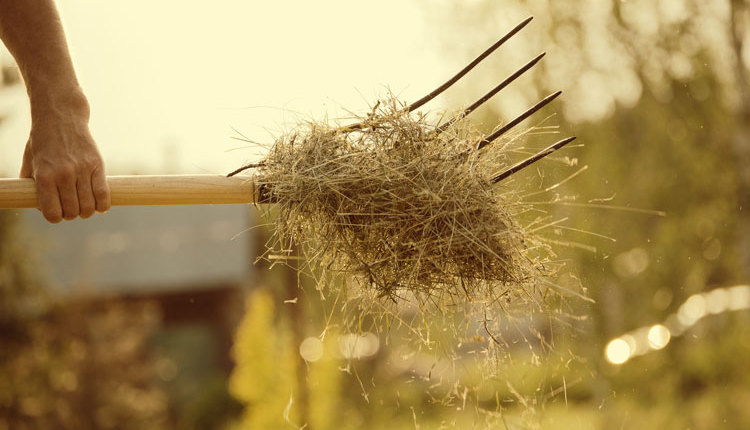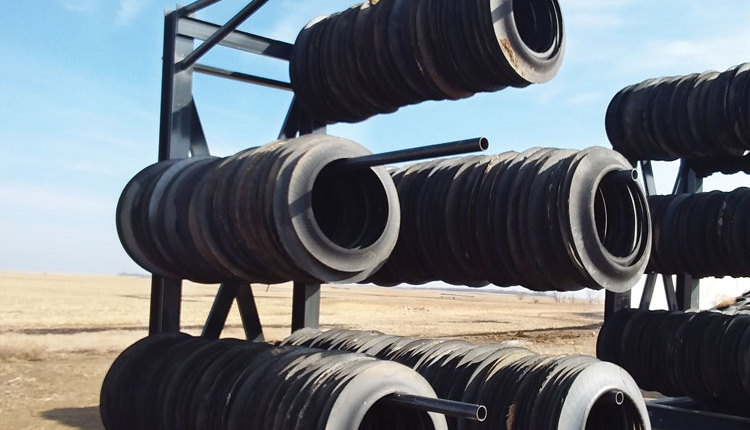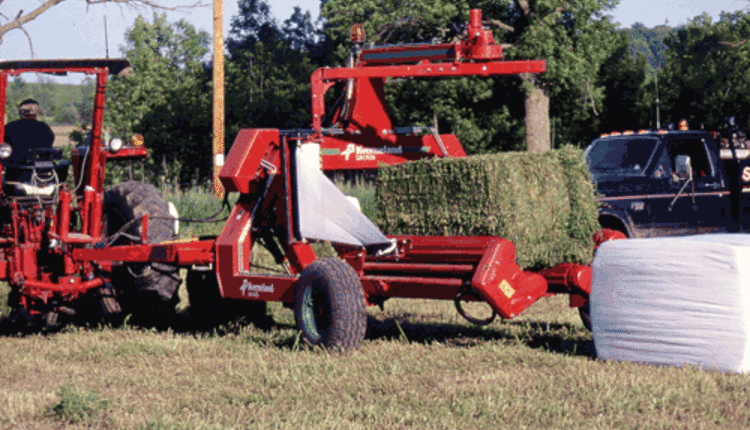The author is with agriculture programs, Washington State University Snohomish County Extension. 
A good tight bale of hay silage with the proper moisture content, carefully wrapped with at least four layers of plastic, and properly stored can remain palatable and nutritious for over two years.
There's a lot more to making top-notch bale silage than simply achieving proper fermentation and harvesting at the proper maturity and moisture. At a Washington State University field day, WSU nutrient management specialist Joe Harrison and forage farmers Karl Hereth and Bruce Gregory shared their thoughts on what it takes to be successful when making bale silage or baleage.
While the science explains what conditions make for good and bad hay silage, it often doesn't provide the practical details that can make for success or failure. It's the farmers actually producing the hay silage who discover the tricks of the trade through trial and error.
Fertilizer, seeding, and pesticides. Adding 100 pounds of nitrogen per acre between first and second cuttings either with manure or fertilizer ensures grass pastures remain actively growing throughout the season. Most fields have weed pressures that build over time. While yearly spraying may be necessary for the worst, most can get by with a broadleaf herbicide spray every other year after first cutting. Reseeding with a straight orchardgrass every fourth year works well in western Washington to ensure maximum production.
Timing. Since sugars are highest in the afternoon, mowing at that time is ideal. Since that isn't practical for larger acreages, the recommendation is to wait until the dew has dried off the grass in the morning to start mowing and finish as the sun goes down and before the evening dew starts to rise during the first hours of dusk.
Baling should take place as soon after cutting as possible. With temperatures above 65 degrees, it can often take place the day after cutting. When temperatures are higher, optimum moisture levels are often attained within 6 to 12 hours. When those conditions are prevalent, rule of thumb is to not cut more than you can bale and wrap before moisture levels drop too low for good hay silage.
Using inoculants. Addition of a bacterial inoculant can ensure a consistently good fermentation. Bacteria sometimes exist by the billions throughout a typical pasture and only need the right set of conditions to start the fermentation process inside a wrapped bale. However, there are occasions when an inoculant can improve the odds. Cuttings done later in the fall, when temperatures are cooler or after a frost, can be helped with the addition of an inoculant to ensure fermentation, even with the cooler temperatures.
Inoculants and acid-based additives can also help boost the shelf life of an opened bale by several days for smaller operations.
Rain. Keeping a constant ear to the weather forecasts is key to developing the timing needed to cut at optimum maturity, dry to the proper moisture level, bale, and wrap before a rain moves through.
If a soaking rain is predicted before the ideal moisture level is attained, it's better to bale and wrap at a higher moisture level than to reduce nutritional levels through the rain leaching nutrients and going through another drying, tedding, and conditioning cycle. If the rain predicted is light, it will likely be better to wait before baling.
Weight. The trade-off in using large bales is weight. Depending on how high the moisture content was when the bales were wrapped, large bales can easily top the scales at well over a ton. Keeping the moisture content a little lower, less than 50 percent, can help make the larger bales a bit lighter while still providing a quality product. In addition, there will be more dry matter available per bale, helping keep consumption rates slower than with a wetter product.
Cutting knives. Some balers are set up with cutting knives set 3 to 4 inches apart. You can often remove every other one and double the distance between cuts without sacrificing quality or fermentation time. This also helps save fuel and time when baling. Since they should be sharpened after every cutting, using half the knives can mean each full set lasts twice as long before replacement.
Depending on how the bales are used, the longer fibers can help maintain bale integrity during handling after the wrap comes off. Bales made with all the knives in place break apart readily after the wrap is removed, sometimes even with the netting still in place.
Feeding. If you end up with some bales at a higher moisture content, above 65 to 70 percent, feed them soon after baling, usually within one to two months. Mix them at least 50-50 with drier bales, or there will be some weight loss. When used in grass-fed operations, be sure to introduce hay silage gradually to animals in the fall, and wean them slowly back onto fresh pasture in the spring.
Plastic disposal. Many regions now have collection services that will provide a dumpster to collect the used netting and bale wrap for recycling. Check with local waste disposal services or extension offices to find out what options exist in your area.
Try it, you might like it . . .
Like any other farming endeavor, making quality hay silage takes some science, some know-how, and a little weather luck. While making round bale silage may not be the ideal answer for every operation's feed challenges, the rapid growth of the product for livestock producers large and small, coupled with the growing price of traditional feedstocks, makes it worth serious consideration.
Click here to return to the Crops & Forages E-Sources
090810_494

There's a lot more to making top-notch bale silage than simply achieving proper fermentation and harvesting at the proper maturity and moisture. At a Washington State University field day, WSU nutrient management specialist Joe Harrison and forage farmers Karl Hereth and Bruce Gregory shared their thoughts on what it takes to be successful when making bale silage or baleage.
While the science explains what conditions make for good and bad hay silage, it often doesn't provide the practical details that can make for success or failure. It's the farmers actually producing the hay silage who discover the tricks of the trade through trial and error.
Fertilizer, seeding, and pesticides. Adding 100 pounds of nitrogen per acre between first and second cuttings either with manure or fertilizer ensures grass pastures remain actively growing throughout the season. Most fields have weed pressures that build over time. While yearly spraying may be necessary for the worst, most can get by with a broadleaf herbicide spray every other year after first cutting. Reseeding with a straight orchardgrass every fourth year works well in western Washington to ensure maximum production.
Timing. Since sugars are highest in the afternoon, mowing at that time is ideal. Since that isn't practical for larger acreages, the recommendation is to wait until the dew has dried off the grass in the morning to start mowing and finish as the sun goes down and before the evening dew starts to rise during the first hours of dusk.
Baling should take place as soon after cutting as possible. With temperatures above 65 degrees, it can often take place the day after cutting. When temperatures are higher, optimum moisture levels are often attained within 6 to 12 hours. When those conditions are prevalent, rule of thumb is to not cut more than you can bale and wrap before moisture levels drop too low for good hay silage.
Using inoculants. Addition of a bacterial inoculant can ensure a consistently good fermentation. Bacteria sometimes exist by the billions throughout a typical pasture and only need the right set of conditions to start the fermentation process inside a wrapped bale. However, there are occasions when an inoculant can improve the odds. Cuttings done later in the fall, when temperatures are cooler or after a frost, can be helped with the addition of an inoculant to ensure fermentation, even with the cooler temperatures.
Inoculants and acid-based additives can also help boost the shelf life of an opened bale by several days for smaller operations.
Rain. Keeping a constant ear to the weather forecasts is key to developing the timing needed to cut at optimum maturity, dry to the proper moisture level, bale, and wrap before a rain moves through.
If a soaking rain is predicted before the ideal moisture level is attained, it's better to bale and wrap at a higher moisture level than to reduce nutritional levels through the rain leaching nutrients and going through another drying, tedding, and conditioning cycle. If the rain predicted is light, it will likely be better to wait before baling.
Weight. The trade-off in using large bales is weight. Depending on how high the moisture content was when the bales were wrapped, large bales can easily top the scales at well over a ton. Keeping the moisture content a little lower, less than 50 percent, can help make the larger bales a bit lighter while still providing a quality product. In addition, there will be more dry matter available per bale, helping keep consumption rates slower than with a wetter product.
Cutting knives. Some balers are set up with cutting knives set 3 to 4 inches apart. You can often remove every other one and double the distance between cuts without sacrificing quality or fermentation time. This also helps save fuel and time when baling. Since they should be sharpened after every cutting, using half the knives can mean each full set lasts twice as long before replacement.
Depending on how the bales are used, the longer fibers can help maintain bale integrity during handling after the wrap comes off. Bales made with all the knives in place break apart readily after the wrap is removed, sometimes even with the netting still in place.
Feeding. If you end up with some bales at a higher moisture content, above 65 to 70 percent, feed them soon after baling, usually within one to two months. Mix them at least 50-50 with drier bales, or there will be some weight loss. When used in grass-fed operations, be sure to introduce hay silage gradually to animals in the fall, and wean them slowly back onto fresh pasture in the spring.
Plastic disposal. Many regions now have collection services that will provide a dumpster to collect the used netting and bale wrap for recycling. Check with local waste disposal services or extension offices to find out what options exist in your area.
Try it, you might like it . . .
Like any other farming endeavor, making quality hay silage takes some science, some know-how, and a little weather luck. While making round bale silage may not be the ideal answer for every operation's feed challenges, the rapid growth of the product for livestock producers large and small, coupled with the growing price of traditional feedstocks, makes it worth serious consideration.
090810_494









